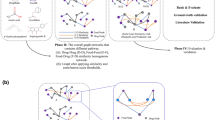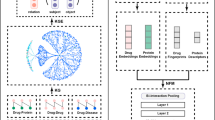Abstract
Drug discovery focuses on understanding different types of interactions from drug-drug interactions (DDIs) to drug-food interactions (DFIs). The main purpose of DFI is to discover how a particular food affects drug absorption, side effects and its effectiveness. The study of drug-food interactions (DFIs) can provide valuable insight into optimizing patient care, adjusting dosages, and improving patient safety.
In this work, we propose a novel workflow where we aim to use a community-based recommender system to infer and identify novel DFIs while incorporating the concept of community profiling and leveraging the power of Graph Neural Networks. We conduct experiments on the DrugBank dataset and use FooDB dataset to learn more about food constituents. Our experiments reveal significant improvements over a number of the latest approaches designed for DFI identification. The findings substantiate that the utilization of multiple graphs to leverage diverse forms of relationships holds the potential to yield better recommendations by extracting complex relationships through the community structure.
Access this chapter
Tax calculation will be finalised at checkout
Purchases are for personal use only
Similar content being viewed by others
References
Wishart, D., et al.: DrugBank 5.0: a major update to the DrugBank database for 2018. Nucleic Acids Research. 46, D1074–D1082 (2018). https://doi.org/10.1093/nar/gkx1037
Wishart, D., et al.: FoodDB: a comprehensive food database for dietary studies, research, and education. Nucleic Acids Res. 37, D618–D623 (2009). https://doi.org/10.1093/nar/gkn815
Ryu, J., Kim, H., Lee, S.: Deep learning improves prediction of drug-drug and drug-food interactions. Proc. Natl. Acad. Sci. 115, E4304–E4311 (2018)
Bourhim, S., Benhiba, L., Idrissi, M.: A community-driven deep collaborative approach for recommender systems. IEEE Access. 10, 131144–131152 (2022)
Rendle, S., Freudenthaler, C., Gantner, Z., Schmidt-Thieme, L.: BPR: Bayesian personalized ranking from implicit feedback. In: Proceedings Of The Twenty-Fifth Conference On Uncertainty In Artificial Intelligence (2012)
Cao, S., Lu, W., Xu, Q.: GraRep: learning graph representations with global structural information. In: Proceedings Of The 24th ACM International On Conference On Information And Knowledge Management, pp. 891–900 (2015)
Tang, J., Qu, M., Wang, M., Zhang, M., Yan, J., Mei, Q.: Line: Large-scale information network embedding. In: Proceedings Of The 24th International Conference On World Wide Web, pp. 1067–1077 (2015)
Wang, D., Cui, P., Zhu, W.: Structural deep network embedding. In: Proceedings Of The 22nd ACM SIGKDD International Conference On Knowledge Discovery And Data Mining, pp. 1225–1234 (2016)
Kipf, T., Welling, M.: Variational graph auto-encoders. In: International Conference On Learning Representations (2017)
Ou, M., Cui, P., Pei, J., Zhang, Z., Zhu, W.: Asymmetric transitivity preserving graph embedding. In: Proceedings Of The 22nd ACM SIGKDD International Conference On Knowledge Discovery And Data Mining, pp. 1105–1114 (2016)
Wang, T., et al.: DFinder: a novel end-to-end graph embedding-based method to identify drug-food interactions. Bioinformatics. 39, btac837 (2023)
Bourhim, S., Benhiba, L., Idrissi, M.: Towards a Novel Graph-based collaborative filtering approach for recommendation systems. In: Proceedings Of The 12th International Conference On Intelligent Systems: Theories And Applications, pp. 1–6 (2018)
Bourhim, S., Benhiba, L., Idrissi, M.: Investigating algorithmic variations of an RS Graph-based collaborative filtering approach. In: Proceedings Of The ArabWIC 6th Annual International Conference Research Track, pp. 1–6 (2019)
Author information
Authors and Affiliations
Corresponding author
Editor information
Editors and Affiliations
Rights and permissions
Copyright information
© 2024 The Author(s), under exclusive license to Springer Nature Switzerland AG
About this paper
Cite this paper
Bourhim, S. (2024). DFI-DGCF: A Graph-Based Recommendation Approach for Drug-Food Interactions. In: Cherifi, H., Rocha, L.M., Cherifi, C., Donduran, M. (eds) Complex Networks & Their Applications XII. COMPLEX NETWORKS 2023. Studies in Computational Intelligence, vol 1141. Springer, Cham. https://doi.org/10.1007/978-3-031-53468-3_33
Download citation
DOI: https://doi.org/10.1007/978-3-031-53468-3_33
Published:
Publisher Name: Springer, Cham
Print ISBN: 978-3-031-53467-6
Online ISBN: 978-3-031-53468-3
eBook Packages: EngineeringEngineering (R0)




